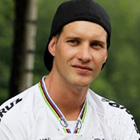Personalities« Back to Personalities Listings

Greg Minnaar
South Africa's World Downhill Mountain Biking Champ Inspired by Mandela
By Rowan Philp
SOUTH AFRICA’S WORLD DOWNHILL MOUNTAIN BIKING CHAMP INSPIRED BY MANDELA
Amid the cheering fans and jostling media, Greg Minnaar quietly touched the top of his helmet after winning his third world championship last year. It bore a large image of a smiling Nelson Mandela—a smile reflected in hundreds of fans who had just seen him defend his world downhill mountain bike title in his home country, against the odds and despite the extreme pressure of South African expectation.
Minnaar is based in Emeryville, California, for half of each year—the World Cup series season—and spends the other half in his home town of Pietermaritzburg, where he won that iconic race. At the time, he said, “I don’t think I am going to have a better experience than that.” Already the “most podiumed” downhill racer on circuit, the 32-year-old—with his three world championships and 15 World Cup victories—has now joined his bike heroes, Nico Vouilloz and Steve Peat, as one of the greats of cycling’s extreme sport.
A high-performance handlebar has been named after him—dubbed the Minnaarbar—and his team, Santa Cruz, recently launched a limited-edition replica of his tailor-made V10 bike. Whereas downhill skiers have smooth slopes to control their death-defying plunges, downhill bikers, often using the same slopes in summertime, must dodge or even deliberately use tree roots, loose logs, drop-offs and rocks to hustle the greatest momentum in timed runs.
Minnaar’s global legend began in earnest at the 2007 World Championship, when he got back on his bike with a dislocated and fractured shoulder and somehow raced fast enough to capture fourth place. He told SABLE, ”Ï remember going over the handlebars, picking up a bruised scapula and a dislocated shoulder. You do take a bit of risk, but it’s planned risk. I like to plan different sections of the course, visualize my lines and decide when to push harder, when to back off a bit.”
In September 2013 at the UCI Downhill World Cup in Austria, he picked up his first season-threatening injury, a torn meniscus in his knee and a major ligament rupture, after his rear wheel slipped on a log. He has spent most of the past six months coaxing his body into recovery.
But during what has become his “longest period being down,” he completed his first Cape Argus Cycle tour—the world’s largest individually timed bike race—last week in March 2014 as part of his recovery training and to support a local charity.
Last month, he made a short visit to the U.S. to join Springbok legend Bryan Habana for a red carpet Hollywood event for the launch of Oakley’s “Disruptive by Design” brand campaign. Now returning to the U.S. for the season—rejoining Santa Cruz and the romantic partner he lives with in Emeryville, Laila Rachki, 32—he says he expects a rebuilding phase before an assault on Steve Peat’s record of 17 World Cup wins. “Two more World Cups would be nice,” he says. The mission will begin in California with up to a week’s therapy with his South African-born performance coach, Lawrence van Lingen, whom Minnaar regards as a genius.
Downhill is the fastest-growing mountain bike sport in which top riders can earn more than $500,000 per year; it is a sport with such technical and safety challenges that he has his own bicycle mechanic in Santa Cruz and an athletic support team, including a dedicated biokineticist. But aside from one-off sports page headlines or viral YouTube clips, the sport remains perhaps a household name below the mainstream in the U.S. and a niche sport in South Africa. And that is alright by the 6’3” athlete, who insists he rides for love of the sport and not for recognition.
But with striking candor, he admits, “I expected more from big wins; at the time, you feel on top of the world, but the next day, life is back to normal. I mean, you’re hit with media interviews after wins, and we have a good time, but it’s not like golf or tennis.”
That may have been the reason for a collective gasp when South Africa’s oldest newspaper, The Witness, did not choose a national cricket star like Hashim Amla or a rugby great like Jean de Villiers as its “2013 South African Sportsman of the Year,” but instead chose Greg Minnaar. Sports Editor for The Witness, Lloyd Burnard, told SABLE that in addition to promoting the sport itself, Minnaar had almost singlehandedly driven a much-needed new identity for Pietermaritzburg as “Africa’s cycling capital.”
Minnaar is bigger than he knows as both a star and a counter-culture rolemodel—perhaps cycling’s answer to snowboard hero Shaun White. He describes downhill trails as “sick,” “gnarly” or “cool” and writes Tweets like this one in 2012: “Someone should record all the excuses roadies use when caught doping, from beers and whiskey to contaminated meat and poisoning...What next?”
Just as downhill is unlike all other sports, Minnaar is unlike other South African role models. In choosing a Madiba image for his helmet, Minnaar was also careful to choose one that reflected the green, gold and black colors of Madiba’s controversial political party, the ANC—a gesture unheard of for sports figures. Minnaar is hardly political as one of his recent issues was a personal boycott of health brownies and the “dead awful” protein shakes promoted by a friend. (He prefers burgers from the Coffeeberry Café near his Pietermaritzburg training routes, which he believes has “the best burger in town.”)
Instead, Minnaar simply respected the fact that Mandela treasured those colors. He also did not choose an image of Mandela wearing one of his trademark colored shirts, preferring one of him in a suit and tie instead. Both were choices that public relations advisors would veto on the spot but showed the utmost respect.
He told his sponsor, Oakley, ”When designing my helmet, I wanted it to be a tribute to South Africa, as well as honoring Madiba. There are three aspects: Mandela, his quote on freedom and the colors of his party. If it wasn’t for this leader, I would never have had the opportunity to become a professional athlete or world champion.” Minnaar feels the same way about his parents. Though he started racing BMX bikes as a four year-old, he switched to off-road motorcycles until he was in his mid-teens, when his parents bought a cycle shop in Pietermaritzburg and supported his training.
After school, he rode mountain bikes up the forest flanks of World’s View, north of the city, and hurtled down the fire breaks. He qualified 12th for the World Cup in Switzerland at age 16. The principal of his school, Alexander High School, helped convince his parents to let Minnaar leave school early and turn pro right away.
The decision didn’t pay off until 2003, when he opted for consistency over high-risk riding and became a regular fixture on podiums at races all over the world—in 29 countries, by his count. “My favorite? Well, I think Japan is an amazing place,” he says. Minnaar says he loves California but notes, “It’s hard to be a foreigner—no credit rating, for one thing.”
In Pietermaritzburg, he wakes at 4:30am; does road cycle training till 7:30 and hits the gym an hour later. At 6’3” and 82kg, he is noticeably bigger than cross-country mountain bikers, and his V10 bike is stronger and heavier in a similar ratio.
“Training is so specialized for downhill; strength is important for the explosion you need on the pedals,” he says. And sometimes, he allows himself to combine his work-hard, play-hard mantra. Ahead of the Cape cycle tour this March, he Tweeted, “Pretty dizzy carbo loading for the Cycle Tour. Is beer gluten-free? Who cares! I’m rolling gluten tomorrow.”
Bio
Rowan Philp served as Chief Reporter and Foreign Correspondent for the Sunday Times in South Africa for most of the past decade—a period broken by stints at the Washington Post as Deputy News Editor; a Harvard/MIT fellowship; and two years as London Bureau Chief. Previously, he was based in Boston and served as the North American correspondent for the Sunday Times and Mail & Guardian, reporting on South African expatriates and diplomats, as well science and innovation. He is currently a chief reporter in South Africa for The Witness daily newspaper of KwaZulu-Natal and Media24.

